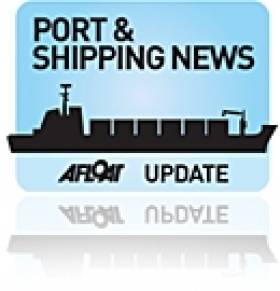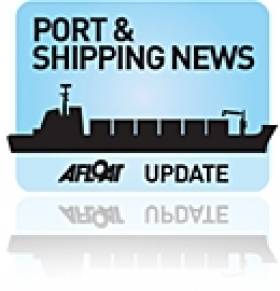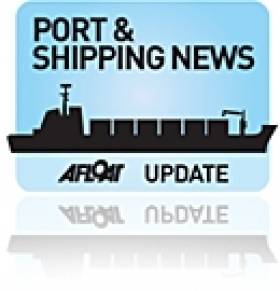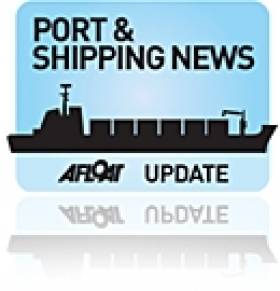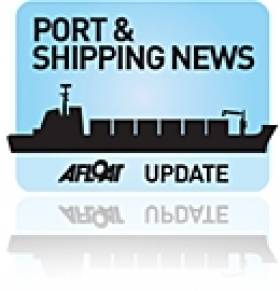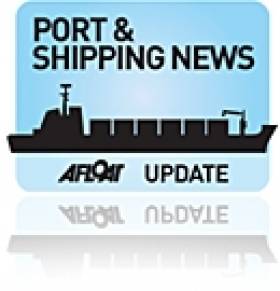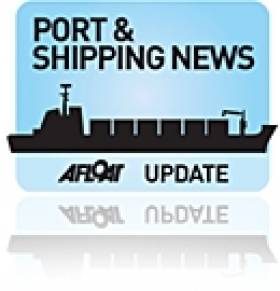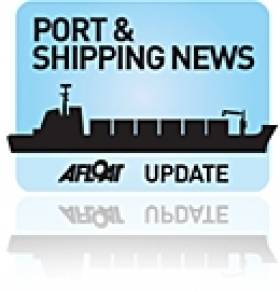Displaying items by tag: Port and Shipping News
Irish Shipping Volumes Up 4% During Q1 2014
#IrishShippingVolumes - Irish shipping and port activity rose by 4% in the first quarter of 2014 when compared to the corresponding period of 2013, according to the latest quarterly iShip Index published by the Irish Maritime Development Office (IMDO).
The latest analysis also indicates that four of the five principal freight segments grew in the first quarter of 2014.
For more details on the iShip Index click this link.
Ardmore Shipping Acquire 49,000dwt Eco-Design MR Tanker
#ArdmoreEcoTanker- Ardmore Shipping Corporation has acquired a 49,997 dwt Eco-design product and chemical tanker built in July 2013 from the STX Offshore & Shipbuilding Co. Ltd., South Korea, for a purchase price of $36 million.
The newbuild is expected to be delivered to Ardmore later this summer between July 1st and August 31, and is intended to be employed either in the spot market or on a one-year time charter.
Upon delivery, Ardmore's fleet will stand at 22 vessels, with 12 in operation and 10 Eco-design product and chemical tankers scheduled to be delivered by the fourth quarter of 2015, the next two of which are scheduled to deliver six months from now, in November 2014.
Anthony Gurnee, Ardmore's CEO, commented: "We are pleased to announce the acquisition of this 2013-built, state-of-the-art, Eco-design MR tanker. This latest addition to our growing fleet of fuel-efficient product and chemical tankers represents the ongoing execution of our expansion strategy and the first step in the accretive deployment of the capital that we raised during our recent equity offering."
Mr. Gurnee continued, "With the addition of this in-the-water, Eco-design tanker, we have increased our fleet size and near-term earnings potential. We are furthermore very happy with the price, which compares favorably with other recently traded Eco-design MR's. The success of this transaction is a result of our measured, disciplined growth strategy, and we will continue to seek out further acquisitions in order to maximize both our earnings potential and long-term shareholder value."
Manx Shipping Scene: Not Just the Preserve of Douglas
#ManxShippingScene – Outsiders could easily conclude that the Manx capital, Douglas is exclusively where all shipping activity takes place given the traditional 'steam-packet' links between the island and the UK and Ireland, not so, head northwards to Ramsey, writes Jehan Ashmore.
Before, we do just a little background to The Isle of Man Steam Packet Co which they claim to be the oldest continually operating passenger shipping company in the world, having begun operations in 1830.
The company, also known simply as the 'steam-packet', remains very much at the heart of Manx shipping scene and playing a pivotal role as the economic, cultural and social life-line in operating the main routes to England and seasonal services to Dublin and Belfast.
While the above combined passenger, car-carrying and freight services of the Steam Packet all converge in Douglas from where there was an attempt of a rival newcomer entering the market this Spring, yet this did not materialise. Having said that, other existing services albeit freight-only operate regularly and further northward along the coast in Ramsey.
However, since the demise of the Ramsey Steamship Co. in its centenary year last year, sadly only one other 'cargo-only' company serves the island, that been Mezeron Limited Freight Services also based from the homeport of Ramsey.
As previously reported on Afloat.ie last year, the Ramsey Steamship celebrated the centenary anniversary with their Ben Maye, which was chartered by Irish trade unions, where notably SIPTU was joined by UK counterparts to mark another event of 100 years ago, the Lockout of 1913.
The Lockout 1913 'commemorative' voyage from Liverpool, was also where the ship's owners had their own centenary celebrations held at Liverpool Cruise Terminal before she set off from Merseyside to the Liffey quays.
The Isle of Man based coastal cargo shipping company was wounded-up because of a £1m pension liability, which led to the sale of the short-sea coasters, the other been the larger Ben Varrey.
The 100-year old company, which traded, to many a small harbour and port throughout the Irish Sea and beyond was sold in late 2013 to Kent based shipowner, Angel Shipping Ltd. The pair of coasters still retain their 'Ben' names and are operated and managed by a wholly-owned subsidiary of Angel, Absolute Shipping Ltd.
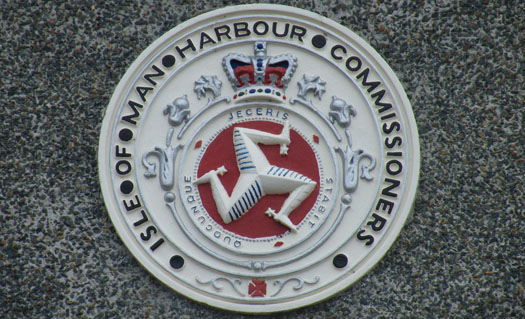
Despite the sale of this famous Manx company, the coasters continue to serve the island and notably their former homeport. This is particularly pleasing to those who have an affinity with the business of coastal shipping, particularly small vessels trading to and from small harbours and ports within the Irish Sea.
In the case of Ramsey, commercial ships are outnumbered by other or smaller leisure craft on the Sulby River, which flows into Ramsey Bay.
These 'other craft' based in the north-eastern port are a fleet of trawlers and yachts that lie along the tidal stretch of the Sulby River, where the Vikings came in the 14th century. The name 'Ramsey' is derived from the Norse word 'Hramns-ey' meaning 'Raven's Isle' this is a reference to a former island at the mouth of the Sulby.
From the Vikings longboats to the present day, where there is a marine engineering boatyard on the far side of the river which can be accessed by roadbridge and also crossed using a swing-bridge, albeit currently under renovation.
Local fishing fleet moored within the harbour at Ramsey
While the Ramsey Steamship are longer in existence, Ramsey, still has a single-shipowner, that been Mezeron Limited Freight Services, whose small coastal general cargoship, Silver River (1963/277grt) was not in port during my visit last week to the Isle of Man.
The classic lines of the Silver River were however not to be seen in Manx waters let alone her usual 'liner' trading services between Ramsey-Belfast and Ramsey-Glasson Dock, where the Lanchashire port also has a marina. Instead the veteran vessel is undergoing a class survey work in Poland at the Morska Yard in Swinoujscie.
Taking her place on services to and from Ramsey was the Isis (1978/674grt), which as pictured was berthed in front of the Mezeron office. The former Channel Islands coaster had traded with Alderney Shipping and originally named David Dorman.
She is currently owned by Great Glen Shipping based in Fort William and is chartered out to Mezeron. While berthed in Ramsey, the foremast flew the Scottish soltaire and at the stern was the Red Ensign of the Douglas registered coaster.
It is expected that Silver River which has been in Manx service since 1986, will resume services from Ramsey next month for Mezeron which has been operating for more than three decades since establishment in 1983.
Among the cargo supplies to support island life are bagged cement, fertiliser and 20-ft (TEU) containers. On rare occasions, the company call to Peel on the island's west coast for the explosives trade.
As for the 'liner' services of Mezeron's two-routes, the Isis make a scheduled arrival to Ramsey from Belfast on Wednesday's and on Thursdays, (as of earlier today) she discharged her cargo.
This late afternoon she was bound for Glasson Dock, where the coast of Lancashire can be seen from Ramsey.
d'Amico International’s Irish Subsidiary Launch Pair of New Medium Range "Eco" Tankers
#EcoTankerNewbuilds - d'Amico International Shipping S.A., an international marine transportation company which has a subsidiary based in Ireland since 2001, has announced the launch of two additional MR "ECO" vessels built at Hyundai Vinashin Shipyard Co Ltd. in Vietnam.
The newbuild pair will join the DIS product tanker market, as the first vessel, MT High Sun (Hull n. S408, 50,000 dwt) was launched and delivered in March last year to Eco Tankers Ltd. (Malta), a joint venture with Venice Shipping and Logistics S.p.A., in which DIS has 33% interest.
The second vessel, MT High Fidelity (Hull n. S409, 50,000 dwt) was too ordered last year and was expected to be delivered to d'Amico Tankers Limited (Ireland) in the third quarter of 2014.
Both vessels are already fixed in time charter to a leading Oil Refining Company for a period of respectively three and two years at very profitable levels.
The above two newbuilding vessels are the latest IMO II MR design with the highest fuel efficiency. The design is the utmost HMD concept of hull shape and propulsion efficiency leading to a fuel saving of 6-7 T/day compare to the average consumption of world existing MR fleet.
The vessels will have an attained Energy Design Index (EEDI) falling already well within the IMO phase-in 3 requirement due for vessels to be built after Jan 1st , 2025, being of 31.5% lower than the current IMO reference line.
d'Amico Tankers Limited fleet includes 38.8 double-hull product tankers (MR and Handysize) with an average age of about 5.8 years (of which 20.3 owned vessels and 18.5 chartered-in vessels), including 4.3 'Eco design' newbuilding vessels delivered in the first half of 2014.
They currently have a total of 11 new 'Eco design' product tanker shipbuilding contracts, which include 7 MR and 4 Handysize vessels, at Hyundai Mipo Dockyard Co. Ltd.
Calling Ports!... Are You the Next ESPO Award Winner? on Societal Integration of Ports
#PortAward -This year, European Sea Ports Organisation (ESPO) will be holding their 6th Award on Societal Integration of Ports.
The awards are to address innovative port projects that lead to environmental improvement for the benefit of the wider port and local community.
If you take innovative actions to improve literally the local environment, if your port tries try to respond to the environmental concerns of the population by setting up specific programmes addressing local air or water pollution, or you are doing something against noise or odours from your port, then you could apply for the ESPO Award 2014 and have the chance to make your project known internationally.
Project submissions have to reach the ESPO secretariat by the 1st July at the latest.
The ESPO Award was established in 2009 to promote innovative projects of port authorities that improve societal integration of ports, especially with the city or wider community in which they are located.
In this way, the Award wants to stimulate the sustainable development of European ports and their cities.
For the 2014 competition, the theme 'Innovative environmental projects' was chosen.
Reducing the environmental impact of port operations and improving the local environmental conditions for the people working and living around the port are key success factors for the societal integration of ports. In fact, ports grant and maintain their license to operate and to grow from their local communities.
Therefore, through the award, ESPO hopes to identify and promote innovative projects set up by ports that address the typical port-city concerns in the environmental field such as local air pollution, water pollution, noise, dust, odours.
The organisers warmly encourage you to participate in this year's competition.
Project submissions must be received by the ESPO secretariat by 1 July at the latest. The ESPO Award will be officially handed out during an Award Ceremony and Port Night, which will take place on 4 November 2014 in Brussels.
The following ports were winners over the last six years: the Port of Gijón (2009), Port of Helsinki (2010), Ports of Stockholm (2011), Port of Genoa (2012) and the Port of Antwerp won last year.
For the terms of reference click HERE and application form can be found from this LINK.
IMDO Shipping Review: Container Market Idle, Rotterdam Europe’s Top Tonnage Port, Short Sea Sector Soft Activity and more
#Ports&Shipping –The latest IMDO Weekly Shipping Market Review includes the following stories as detailed below.
Container Market: Idle box - fleet falls but overcapacity prevalent - The idle containership fleet has edged below 2% of the overall fleet for the first time since last September. Figures from Lloyd's List Intelligence show that total capacity of inactive vessels fell to 335,640 TEU last week, standing lower than for the corresponding week over the last two years, when 2.6% of the fleet was idle.
Rotterdam Port: Volume increases maintain Europe's top spot- The Port of Rotterdam maintained its position as Europe's largest tonnage port in 2013, with throughput totalling some 440.5m tonnes. Rotterdam experienced a slight increase in overall throughput as dry bulk volumes rose amid declining liquid cargoes. Dry bulk volumes increased strongly, rising 12.8% from 2012 to 89.2m tonnes, with particularly noticeable growth of around 20% in coal throughput to 30.7m tonnes.
Short Sea Market: Weekly update - The European Short Sea Bulk market saw flat to softer activity last week according to H.C. Shipping & Chartering's latest report. The market remained on its same trajectory, experiencing the continued downward trend that started developing in early April which has since become prevalent. The supply/demand balance is reportedly skewed with large volumes of spot tonnage available but struggling to find cargoes.
For more on each of the above and other stories click the PDF downloadable IMDO Weekly Markets Review (Week 21). In addition to coverage on Afloat.ie's dedicated Ports & Shipping News section.
Irish Cargoship Re-floated at Mouth of Drogheda Port
#ArklowRuler – As previously reported, Arklow Ruler (2006/2,999grt), which ran aground at the entrance of Drogheda Port at the mouth of the Boyne, was eventually re-floated late this morning, writes Jehan Ashmore.
A previous attempt to re-float the Irish-flagged 80m vessel off the Co. Louth port's northern breakwater at high-tide had proved unsuccessful.
At the same time of this morning's departure of Arklow Ruler bound for Antwerp, the port re-opened for business as the pilot launch cutter, Boyne Protector attended another cargoship.
The incident follows a similar grounding in 2010 by a younger sister, Arklow Raider in which the MCIB investigated into the vessel which went onto a sandbank in the same vicinity.
IMDO Shipping Review: ‘Box’ Ship Demolitions Up, Private Funding Could Upset Recovery, Solution to Satellite Blackout and more
#Ports&Shipping –The latest IMDO Weekly Shipping Market Review includes the following stories as detailed below.
Container Market: Demolitions to hit new record in 2014 - A record number of container ships are set to be scrapped this year, as reported demolitions in the first four months of the year reached 212,000 twenty equivalent units (TEU), up 27% year-on-year.
Shipping Industry: Private equity funding could threaten recovery - The rise of private equity funding in the shipping industry, which has seen billions of dollars invested in new vessel orders, threatens to cut short the sectors emergence from its worst downturn since the 1980's, Reuters have reported.
Technology: Radio navigation solution to satellite blackouts -Europe has yet to come to terms with the danger that satellite blackouts and signal jamming present for the maritime industry, Reuters reported last week.
Presently, the industry relies on satellite-based GPS and GLONASS (Global Navigation Satellite System) for time and positioning. However, the General Lighthouse Authorities of the UK and Ireland (GLA) have pioneered a radio-based back-up system, called eLoran, which would continue to provide users with the correct time and vessel position in the event of a loss of satellite signal due to solar weather effects, interference or even intentional jamming of satellites.
Irish Economy: Trade surplus at six-year low - March's preliminary figures from the CSO indicate the trade surplus fell by €732m to €2.4bn, the lowest seasonally adjusted surplus since July 2008. Seasonally adjusted exports fell 4% (€256m) to €6.9bn from February while seasonally adjusted imports rose 12% (€437m) to €4.5bn in what analysts described as disappointing data.
Comparing March year-on-year, the value of exports decreased by €524million (-6%) to €7.56bn with the main drivers being organic chemicals decreasing 16% and medical and pharmaceutical products falling 10%.
For more on each of the above and other stories click the PDF downloadable IMDO Weekly Markets Review (Week 20). In addition to coverage on Afloat.ie's dedicated Ports & Shipping News section.
#ICGinterimstatement – Irish Continental Group (ICG) has issued below this interim management statement which covers carryings up to 17 May 2014 (i.e. 20 weeks) and financial information for the first four months of the year, i.e. January to April.
Volumes (Year to date, 17 May 2014)
Change
Passengers: 441,100 (0%)
Cars: 95,000 (+5%)
RoRo Freight: 87,900 (+18%)
Container Freight (TEU): 107,800 (+1%)
Terminal Lifts: 69,700 (+6%)
It should be noted that ICG's business is significantly weighted towards the second half of the year when normally a higher proportion of the Group's operating profit is generated than in the first six months.
During the period we inaugurated our weekly Dublin to Cherbourg service, operated by the recently chartered 'Epsilon', alongside 8 additional round trips on Dublin-Holyhead. Total sailings operated across all routes were up as a result by 17%. The financial results for the four months reflect the additional costs of operating the 'Epsilon' during the start-up phase on both the Dublin-Cherbourg and Dublin-Holyhead routes.
In the 20 weeks up to 17 May 2014, Irish Ferries carried 95,000 cars, an increase of 5% on the previous year. While car passenger numbers were up, in line with the car volumes, total passenger volumes were in line with the previous year at 441,100 due to a fall in foot passenger carryings.
In the Roll on Roll off freight market, Irish Ferries carried 87,900 units, an increase of 18% compared with the same period in 2013, reflecting the additional capacity of the 'Epsilon' and a growing freight market.
Container freight volumes shipped increased 1% to 107,800 TEU (twenty foot equivalent units), while units handled at our terminals in Dublin and Belfast rose 6% year on year, over the same period, to 69,700 lifts.
In the first four months of the year, Group revenue rose 5.8% to €76.7 million, compared with €72.5 million in the same period last year. Operating costs (before depreciation & amortisation) were 9.0% higher at €73.8 million, versus €67.7 million the previous year, mainly reflecting the incremental operational and port costs of operating 'Epsilon'.
Earnings before interest, tax, depreciation and amortisation (EBITDA) were €2.9 million compared with €4.8 million in the same period in 2013. The operating loss was €2.6 million compared with an operating loss of €1.1 million in 2013. There was a net finance charge of €1.7 million, down €0.3 million compared with the previous year. The loss before tax was €4.3 million (2013: loss of €3.1 million).
Following the (previously announced) accelerated receipt of charter hire on the deferred sale of the vessel, 'SPL Princess Anastasia' (formerly Pride of Bilbao), to St Peter Line of St Petersburg, Russia, the Group's net debt at the end of April was €72.3 million compared with €93.4 million at 31 December 2013.
Transport Organisations Issue Common Statement on State-Aid Clearance of TEN-T Projects
#TEN-Tprojects - European Sea Ports Organisation (ESPO) together with several associations in the transport sector today, have sent a common statement to the European Commission on state-aid clearance in the context of TEN-T projects.
The undersigning associations in the transport sector consist of ESPO, the European Association with tolled motorways, bridges and tunnels (ASECAP), the Community of European Railway and Infrastructure Companies (CER), the European Federation of Inland Ports (EFIP), the European Rail Infrastructure Managers (EIM), and the International Road Transport Union (IRU).
Associations have asked to streamline procedures within the European Commission in such a way as to ensure that the compatibility of all elements of the funding of a project with EU law can be assessed during the general TEN-T application process.
A positive TEN-T funding decision should entail the legal certainty that the possible use of state aid for the same project will not be too easily challenged at a later stage. The common statement can be found HERE.


























